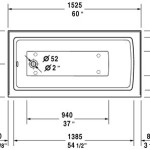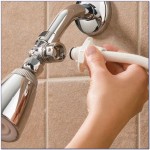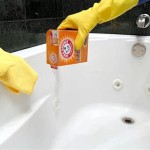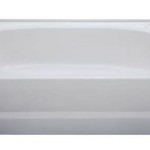Bathtub Water Spout Leaking: Causes, Diagnosis, and Repair
A leaking bathtub water spout can be a frustrating and wasteful plumbing problem. It not only causes unnecessary water consumption, leading to higher water bills, but it can also damage the surrounding areas due to constant dampness. This article provides a comprehensive guide to understanding the common causes of a leaking bathtub water spout, diagnosing the issue, and outlining the necessary steps for repair, enabling effective troubleshooting and resolution of this plumbing concern.
Identifying Common Causes of a Leaking Bathtub Water Spout
The primary reason for a leaking bathtub water spout stems from issues within the diverter valve or the spout itself. The diverter valve is responsible for directing water flow either to the bathtub spout or the showerhead. Wear and tear, mineral buildup, or damage to the valve's internal components can prevent it from completely shutting off the water flow to the spout when the shower is in use, resulting in a persistent drip.
Another significant factor is the condition of the O-rings and rubber washers within the spout assembly. Over time, these components can degrade, crack, or become brittle due to exposure to water, temperature fluctuations, and the chemicals present in tap water. A compromised O-ring or washer fails to create a watertight seal, allowing water to seep through and manifest as a leak.
Furthermore, the spout's connection to the water supply pipe behind the bathtub wall can be a source of leaks. If the connection is loose, corroded, or improperly sealed, water can escape from this point. The type of connection, whether threaded or slip-fit, influences how the leak manifests and the corresponding repair method. Threaded connections might loosen over time, while slip-fit connections rely on tight-fitting O-rings that can deteriorate.
The water pressure within the plumbing system can also contribute to leaks. Excessively high water pressure can exacerbate existing weaknesses in the spout assembly, putting additional stress on the diverter valve and seals. This increased pressure might force water through even small imperfections, leading to a more pronounced leak.
Finally, the material of the spout itself can play a role. While most spouts are made of durable materials like brass or chrome-plated metal, they can still be susceptible to corrosion or cracking, especially in areas with hard water. Corrosion can create pathways for water to escape, and cracks, even hairline ones, can allow water to seep through.
Diagnosing the Source of the Leak
Accurately diagnosing the source of the leak is crucial for an effective repair. The first step involves a careful visual inspection of the bathtub spout. Look for any signs of visible damage, such as cracks, corrosion, or mineral buildup around the spout's base and connection points. Pay close attention to the area where the spout meets the wall, as this is a common location for leaks.
Next, examine the diverter valve. Turn on the water and switch between the bathtub spout and the showerhead multiple times. Observe if the leak continues consistently regardless of the diverter position, or if it only occurs when the shower is in use. If the leak only appears when the shower is running, the issue is likely related to the diverter valve. If the leak persists regardless of the diverter position, the problem might be with the spout itself or its connection to the water supply pipe.
To further pinpoint the leak's origin, dry the area around the spout and the wall with a clean cloth. Then, carefully observe where the water is first appearing. If the water is originating from the base of the spout where it meets the wall, the leak is likely due to a faulty connection or damaged O-rings/washers within the spout assembly.
Consider the age and condition of the spout. If the spout is old or shows signs of significant wear and tear, it might be more cost-effective to replace it entirely rather than attempting to repair individual components. Also, consider the type of spout. Some spouts are designed for easy removal and replacement, while others require more specialized tools and techniques.
Checking water pressure might require a pressure gauge attached to an outdoor faucet or another suitable connection point in the plumbing system. If the water pressure is excessively high (typically above 80 PSI), a pressure regulator might be necessary to prevent future leaks and damage to other plumbing fixtures.
Repairing a Leaking Bathtub Water Spout: A Step-by-Step Guide
Before beginning any repair work, it is essential to shut off the water supply to the bathtub. The shut-off valves are typically located near the bathtub or in the basement beneath the bathroom. If individual shut-off valves are not available, the main water supply to the entire house might need to be turned off. This ensures a safe and dry working environment.
If the spout is connected via a threaded connection, it will likely need to be unscrewed. To remove the spout, grip it firmly and turn it counterclockwise. It might be necessary to use a wrench or pliers, but be careful not to damage the spout's finish. Protect the finish with a cloth or towel when using tools.
Once the spout is removed, inspect the threads on both the spout and the water supply pipe. Clean off any mineral buildup or corrosion with a wire brush. If the threads are damaged, the pipe might need to be rethreaded or replaced, which is best left to a professional plumber.
If the spout is connected via a slip-fit connection, it is typically held in place by a set screw located on the underside of the spout. Loosen the set screw with an Allen wrench or screwdriver. Once the set screw is loose, the spout should slide off the water supply pipe.
Examine the O-rings and washers within the spout assembly. Replace any worn, cracked, or brittle O-rings or washers with new ones of the same size and material. Apply a plumber's grease to the new O-rings before reassembling the spout. This helps to create a watertight seal and prevents future deterioration.
If the leak is originating from the diverter valve, the entire valve assembly might need to be replaced. This typically involves removing the handle and trim plate to access the valve cartridge. Carefully remove the old cartridge and replace it with a new one of the same make and model. Ensure that the new cartridge is properly seated and secured.
When reinstalling the spout, apply Teflon tape to the threads of the water supply pipe before screwing the spout back on. This helps to create a watertight seal and prevents leaks. Tighten the spout securely, but avoid over-tightening, as this can damage the threads or the spout itself.
For slip-fit connections, slide the spout back onto the water supply pipe and tighten the set screw. Ensure that the spout is securely attached and does not wobble. Test the connection for leaks by turning on the water supply and observing the spout for any signs of dripping.
After completing the repairs, turn on the water supply slowly and carefully. Monitor the spout and the surrounding area for any signs of leaks. If any leaks are detected, re-examine the connections and components to identify the source of the problem and make any necessary adjustments.
If the water pressure is deemed to be too high, installing a pressure regulator on the main water line can help to prevent future leaks and damage to plumbing fixtures. A pressure regulator reduces the incoming water pressure to a safe and consistent level.
In cases where the repairs are complex or require specialized tools, it is advisable to consult with a qualified plumber. A professional plumber can accurately diagnose the problem and perform the necessary repairs safely and efficiently.

How To Fix A Leaking Bathtub Faucet The Home Depot

How To Fix A Leaking Bathtub Faucet The Home Depot

How To Fix A Leaking Bathtub Faucet Diy Family Handyman

How To Fix Dripping Faucet Bathtub And Kitchen

How To Fix A Leaky Bathtub Faucet 6 Ways Stop Drips

Complete Steps To Replace An Old Leaky Tub Spout

How To Fix A Leaking Bathtub Faucet The Home Depot

How To Fix A Leaky Bathtub Faucet In 30 Minutes Diy Tips

Leak How Do I Prevent This Bath Faucet From Leaking While The Shower Is Running Home Improvement Stack Exchange

How To Fix A Leaky Bathtub Faucet Blue Collars








